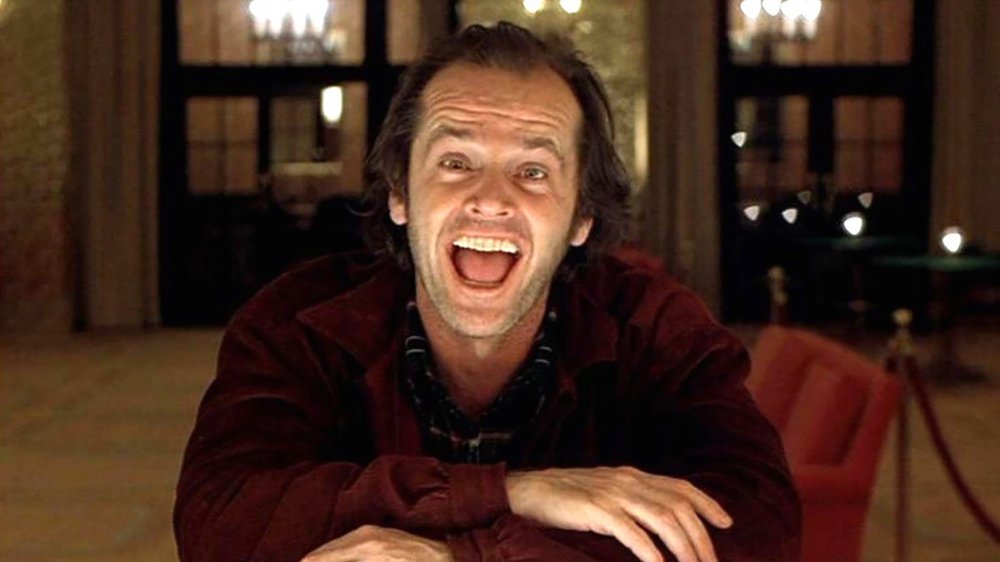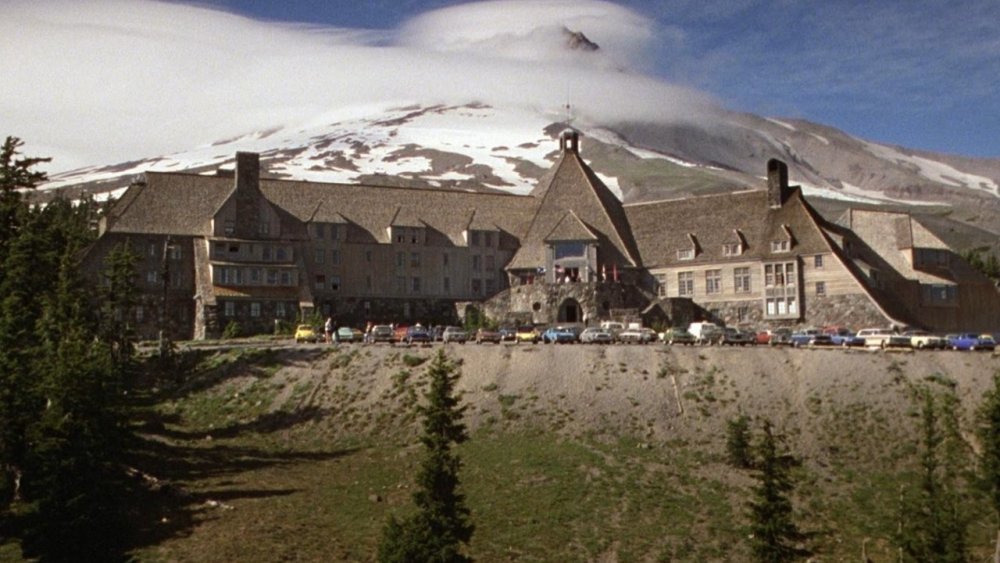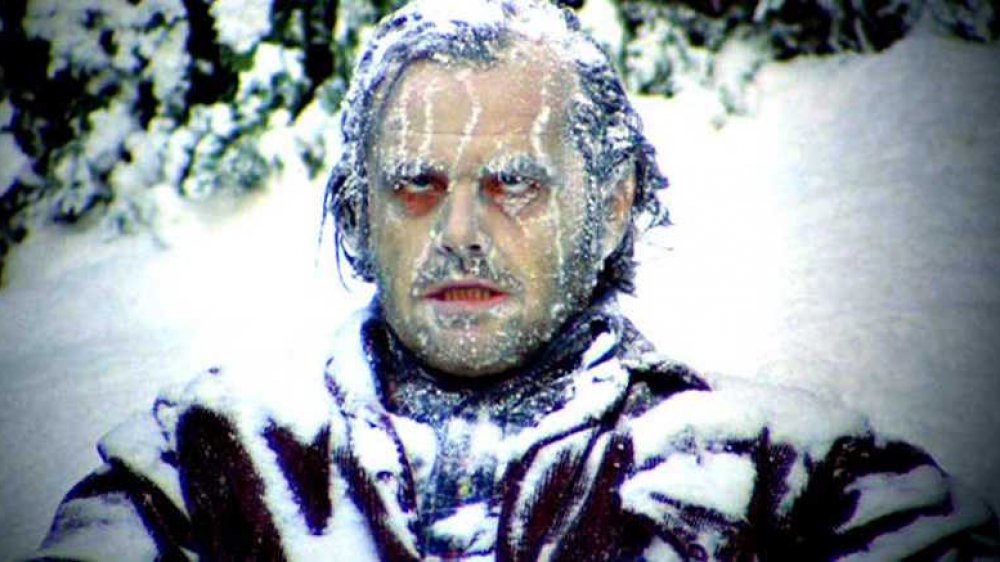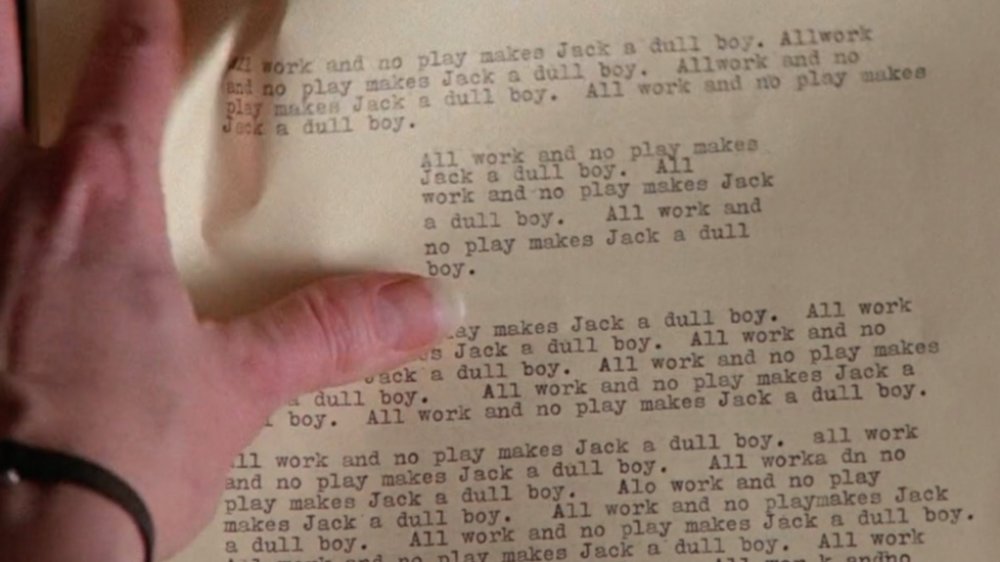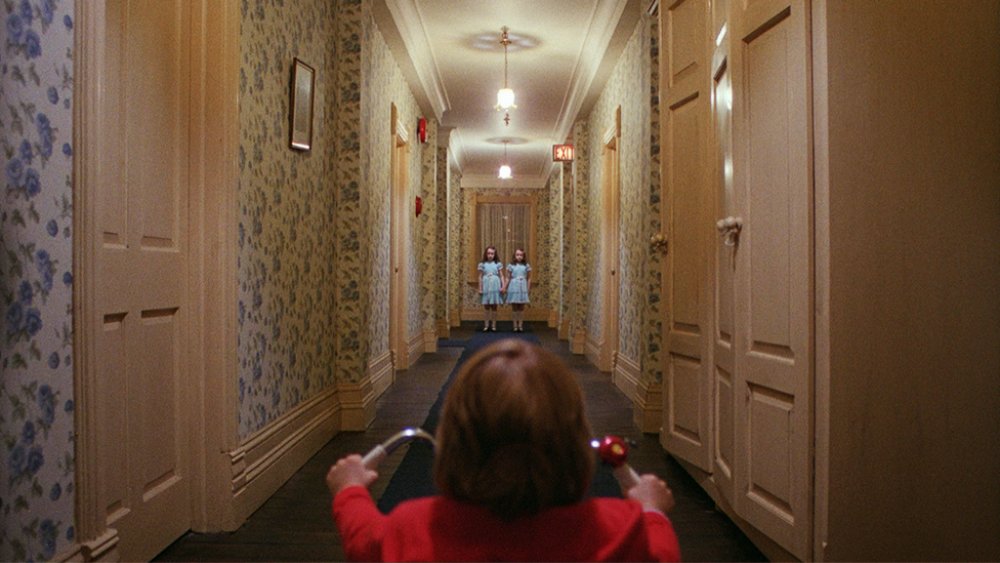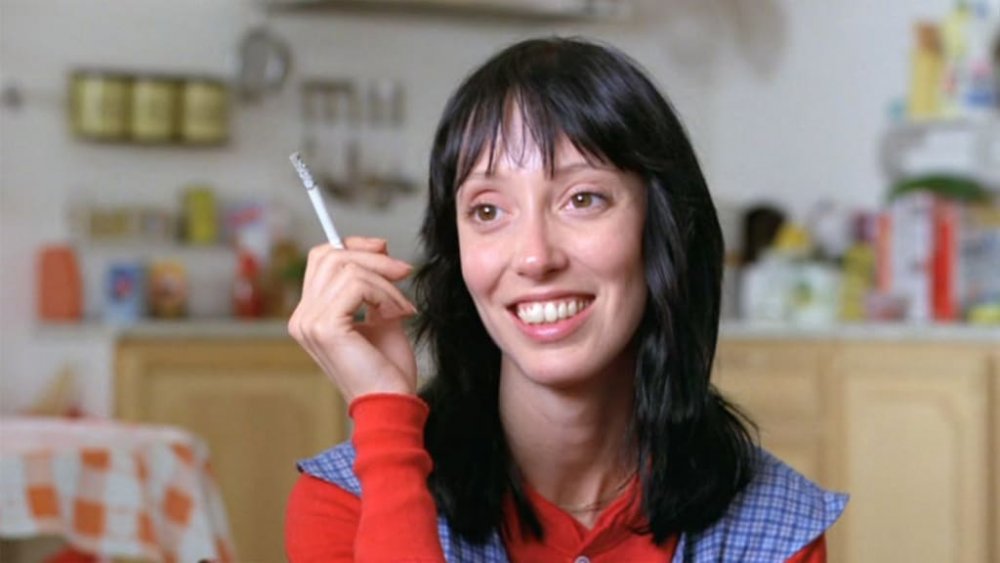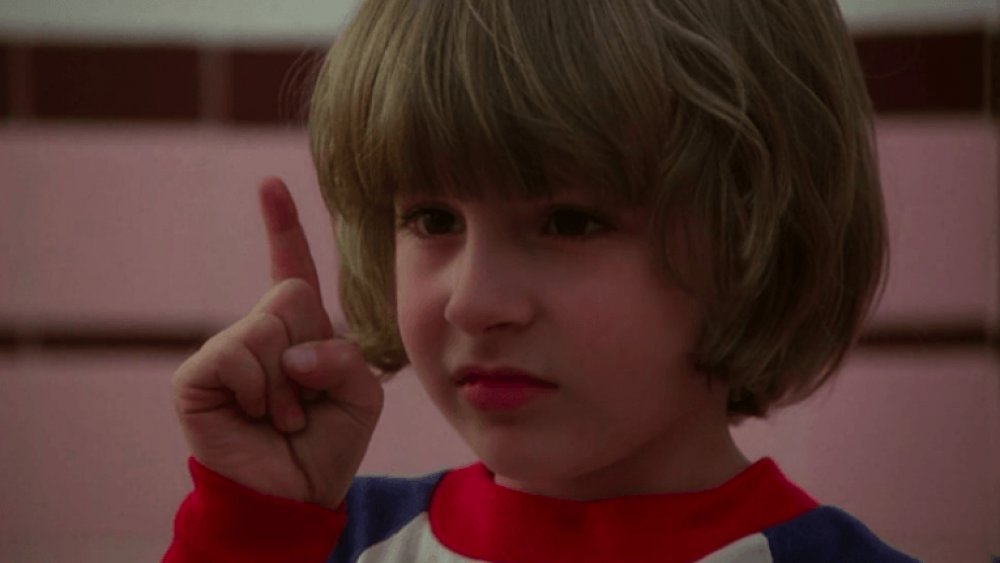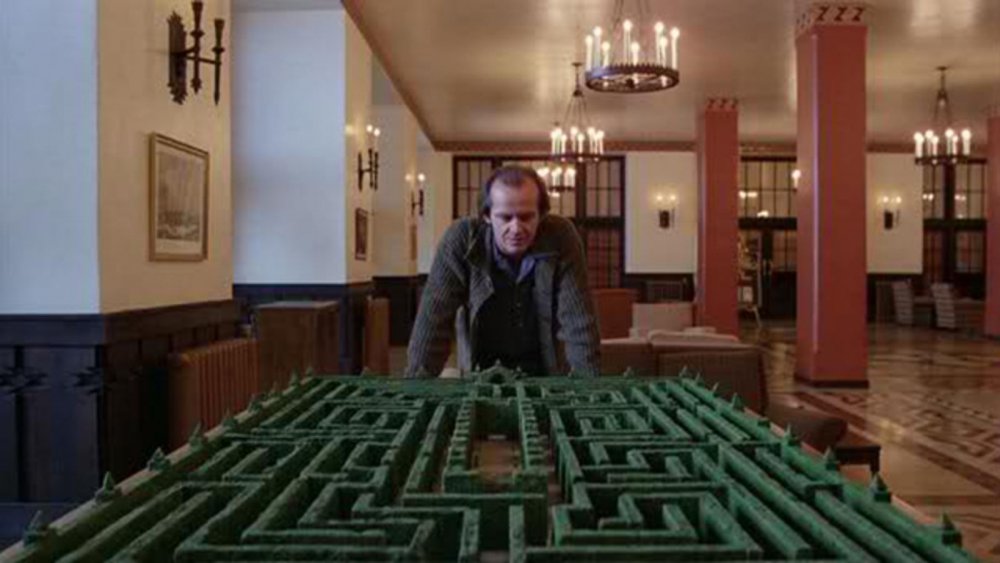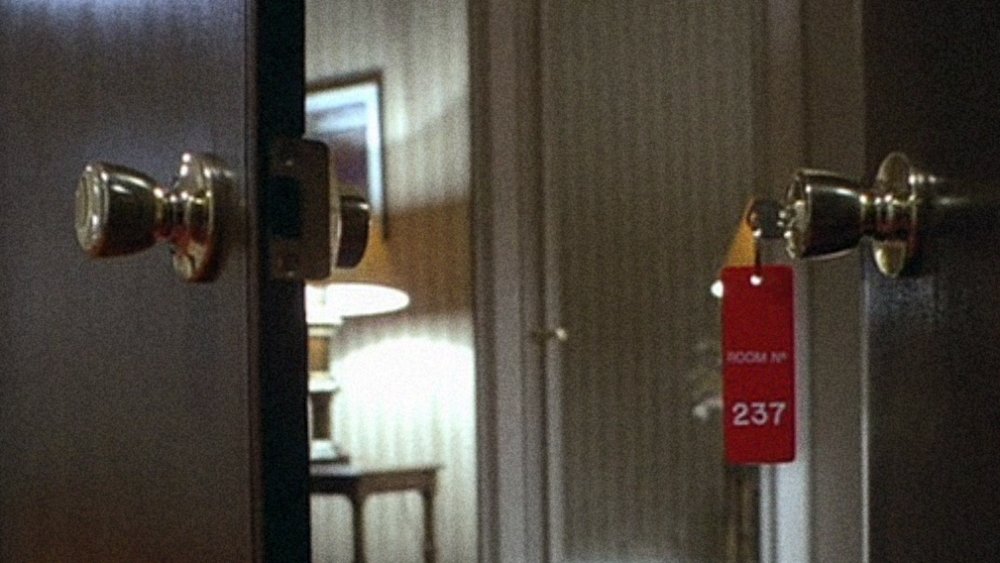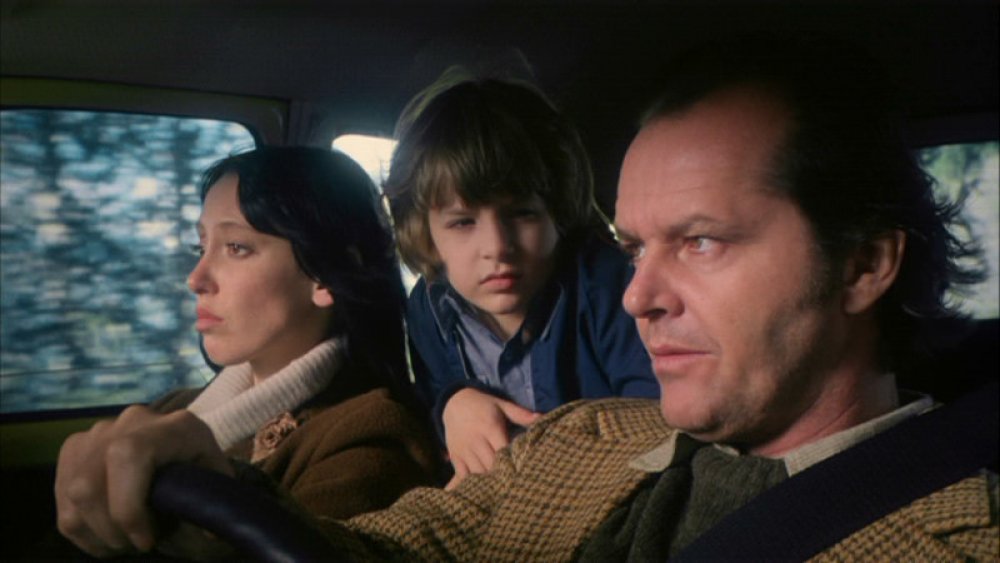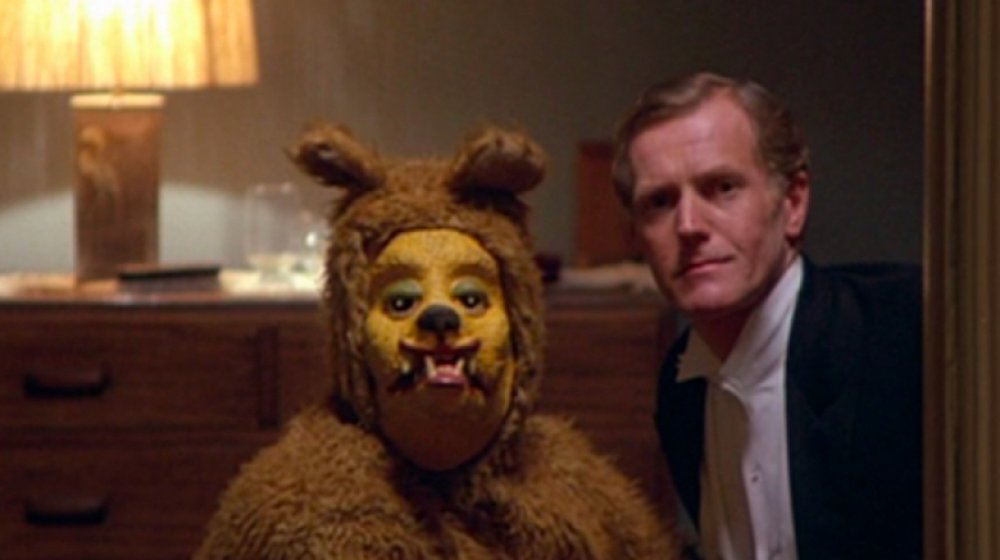How The Shining Book Differs From The Movie
Since the release of Stanley Kubrick's now-classic 1980 adaptation of Stephen King's The Shining, King has made no secret about his profound dislike of the movie in spite of it being considered a cinematic masterpiece. King went so far as to call the film a "big, beautiful Cadillac with no engine in it," as well as pointing out that Jack Nicholson's Jack Torrance had no character arc and Shelly Duvall's Wendy was "one of the most misogynistic characters put to film." Yikes.
But really, his main gripe was the fact that Kubrick's version strays so far from the original text that the movie completely alters the important foundational themes and messages King got across beautifully in his novel. The Shining book is about a traumatized man named Jack Torrance who's possessed by an evil hotel that wants to devour his telepathic son, Danny. "This inhuman place makes human monsters," King writes in The Shining, and in his book, it indeed does. In Kubrick's vision, however, the human monsters already exist, and the hotel calls to them, encouraging them to commit new heinous acts of violence.
But that's not all that's different between The Shining movie and the book. In fact, in some ways, it's almost easier to point out the handful of things that are the same since the two versions of The Shining are so phenomenally unalike. From the creepy twins to the bleeding elevator, here are many ways King's The Shining novel differs from Kubrick's movie.
The nature of the Overlook's evil is completely different
In both versions of The Shining, Jack Torrance is a troubled man with alcoholism in his past. However, in the book, a horrific childhood with an abusive, alcoholic father is the driving trauma that leads to Jack's addiction and anger issues as an adult. He's constantly struggling to overcome these things until the evil in the Overlook Hotel possesses him and encourages him to kill. In the novel, the ghosts encourage Jack to break his 14-month sobriety, and the Overlook's goal is to eat Danny Torrance, whose incredible psychic powers serve as a battery for the demonic building.
In Kubrick's movie, Jack is only sober for five months. The film implies that Jack's alcoholism, anger problems, and violent behavior have always been tied to the hotel. Also, there's one line from the novel that Kubrick anchored himself to while crafting his version of the story, and that's when the ghost of Delbert Grady tells Jack that he's "always been the caretaker." In the book, this line serves to manipulate Jack into attempting to murder his son. In the movie, reincarnation is implied, evidenced by the final photograph of Jack at the Overlook in 1921. And no, Jack doesn't show up in any photos in the book.
In other words, Kubrick turned a story about surviving childhood trauma and domestic violence into a portrait of Jack Torrance's cabin fever and latent psychosis erupting into murder. It's no surprise King was upset about this.
The Shining endings couldn't be more different
In the book, Jack Torrance fights back against the evil powers haunting the hotel and attempting to possess him. Just as the hotel, through Jack, is about to bash five-year-old Danny to death with a roque mallet, Jack fights his way through and gives his son enough time to save himself, his mom, and Dick Halloran. Using the Overlook's boiler to get the job done, Jack blows himself and the hotel up to stop its cycle of demonic violence.
As for Dick Halloran, he survives in the book and ends up getting Danny and Wendy to safety, unlike dying brutally in the movie. But he doesn't escape without taking a huge beating, though. Jack Torrance uses the mallet to break Halloran's jaw, as well as Wendy's ribs and upper vertebrae, in several pages of brutal fight scenes.
There aren't any mallets in the movie version of The Shining. Instead, Jack shows up with something far scarier: an ax. And at the end of the film, Danny leads his ax-wielding dad into a frozen hedge maze where Jack dies of exposure. In the book, however, it was only Delbert Grady who chased his family down with an ax to murder them.
Jack Torrance is writing a play in King's novel
Both book and movie Jacks are published writers and English teachers. But book Jack isn't writing a novel. Instead, he's writing a play called The Little School, which is loosely based on Jack's previous job at a New England prep school from where he was fired for beating up a student. George Hatfield had slashed Jack's tires after Jack cut him from the debate team, and in a sober rage, Jack almost killed the kid. But once the evil in the Overlook begins taking hold of Jack, it leaves him a strange gift. After finding a scrapbook of articles about the sordid history of the hotel's connections to the mob, human trafficking, murder, and suicide, Jack ditches the play and decides he's going to write a tell-all about the Overlook, instead.
In The Shining movie, Jack is writing a novel that turns out to be the phrase "all work and no play makes Jack a dull boy" written over and over again on hundreds of pages. This isn't in King's book, but Kubrick does give a small nod to the scrapbook Jack finds in the novel, as there's a huge tome of clippings next to Jack's typewriter in the main Overlook lobby. However, in the book, Jack doesn't write in the lobby at all, but rather in his caretaker quarters.
His writing aside, Jack in the novel is open about his alcoholism, as well as hurting his son when he was drunk, confessing that he broke Danny's arm by accident to several people in bouts of remorse. In the film, Jack dislocates Danny's shoulder instead of breaking it, and he insists it really wasn't his fault. After all, Danny shouldn't have been messing with his stuff.
Many iconic elements from the movie aren't in the book
Even people who haven't seen The Shining film will be able to identify the creepy twins who taunt Danny and the image of blood spilling out an elevator. The geometric art deco red, gold, and black carpet that Danny rides his trike on is also immediately associated with The Shining movie, along with the Gold Bar where Jack has his conversations with Delbert Grady and Lloyd the ghostly bartender. But none of this stuff is in the book.
As for the freaky girls, Delbert Grady had two daughters in the novel, but they were six and eight. So yeah, they obviously weren't twins. Plus, they aren't described as dressing the same. On top of that, in the book, the only problematic elevator is a manual one that begins running by itself as sounds of a 1920s party drift through its doors. When the elevator finally stops, Wendy finds it's full of confetti and masks. In the book, the hotel's decor is Victorian and Baroque, so the carpet is actually dark green with a jungle and floral motif suggesting snakes. And believe it or not, Danny doesn't ride a trike inside the hotel in the book.
In the novel, the Gold Bar is called the Colorado Lounge, while in the movie, the Colorado Lounge is the main hallway that's decorated with Native American textiles and artifacts. In the film, Ullman (the manager) says that the hotel was built on an "ancient Indian burial ground," which isn't the case in the novel at all. Instead, the hotel is possessed by a demonic spirit that may have survived even after Jack burned the Overlook to the ground.
And wouldn't you know it? The red art deco bathroom in the movie where Jack and Grady have their terrifying conversation also isn't in the book.
The Wendys are as different as night and day
Wendy Torrance in the movie — played by Shelly Duvall — is tall, skinny, dark-haired, and has a sensitive personality. She dresses in frumpy high-necked shirts with baggy over-frocks and comfortable shoes. Movie Wendy is not conventionally attractive, and she smokes cigarettes. She's timid and cowers in the face of Jack's bullying, screaming and weeping as her husband loses his mind. There's very little physical contact between movie Wendy and Jack, and movie Jack seems to hold her in contempt straight from the get-go.
This couldn't be more different than the Wendy Torrance in the book, who's a voluptuous blonde Amazon. She stands up to her husband from the beginning. She's strong, and she fights hard for herself and her son. She isn't afraid to leave Jack if need be to protect herself and her boy, and she isn't afraid to tell him this, either. There's a great deal of complicated love between book Wendy and Jack, who are often kissing, embracing, and even sexually active right up until the hotel fully takes hold of her husband.
When the blood starts hitting the fan, Wendy uses a huge kitchen knife instead of a baseball bat to almost mortally wound her husband. And in the book, she takes a monumental beating from Jack with the roque mallet that breaks her ribs, her upper vertebrae, and causes internal bleeding, all of which she survives in order to save her son and Dick Halloran. In short, book Wendy is a badass, and movie Wendy is a wimp.
Danny and his friend Tony are presented differently
In The Shining novel, Danny's "imaginary" friend Tony speaks to nobody but Danny in visions that cause the kid to pass out. Even Danny doesn't properly see Tony except as the shadows of an older boy until deep into the novel, when Danny realizes Tony is actually himself in ten or so years.
But in the movie, Tony is indicated by Danny's index finger moving up and down, as well as Danny's own voice made scratchy. In the movie, Danny says, "Tony is the little boy who lives in my throat," and Tony often talks to Wendy, as well as Jack.
This isn't all that's different about Danny in the book, either. Book Danny is a precocious kid with a huge vocabulary for a five-year-old because he's insisting on learning how to read early. After all, Tony is constantly sending him messages with signs in them that Danny can't make out, and he wants to be able to understand. If he could, he would've figured out the "REDRUM" vision Tony sent him at the start of the book much sooner than he does, which is also different from the movie. In Kubrick's version, it's Wendy who figures out "REDRUM" is "MURDER" spelled backwards in the mirror, not Danny.
In the movie, Danny is seven and prefers watching cartoons, playing with toy cars, and riding his trike around the hotel rather than reading books. But hey, he's also pretty skilled at solving mazes, and that's a valuable skill when your dad is a homicidal maniac.
The Shining novel features some murderous shrubs
An iconic feature of Kubrick's The Shining is the elaborate hedge maze attraction that Mr. Ullman says you need at least an hour to get in and out of. There's a replica of the hedge maze in the main lobby of the Overlook, and Jack stares intently into it, as if foreshadowing his ultimate demise within its green walls.
In the novel, instead of a hedge maze, there's a topiary garden filled with huge hedge animals like a dog, a rabbit, buffalo, and two crouching lions. There's also a playground next to the garden that features a kind of miniature of the Overlook Hotel that's still large enough to open on hinges so that children can play inside. In the novel, the hedge animals come to life and first attack Jack, before later wounding Danny. And at the end of the book, the hedge animals line up in front of the hotel door and brutalize Dick Halloran, trying to prevent him from saving Danny and Wendy.
Room 217 versus Room 237
Since there was a real-life room 217 in the hotel where The Shining movie was filmed, Kubrick changed the room number to avoid frightening future guests. But this isn't all that Kubrick altered about the uber-haunted room from the book. In King's novel, Danny is drawn to room 217 but can't get in. While he's in the hallway, a fire hose drops from its mooring and attacks him like a huge snake. This isn't in the movie.
In the book, Danny decides to get the passkey for room 217, and when he goes inside, a bloated corpse in the bathtub chokes him out. Danny goes into a catatonic state, and Wendy thinks that Jack did it. The way she accuses him is fierce and forceful. When Danny comes to and tells them about the woman in room 217, Jack doesn't see anyone there. But later, he dreams about the room, and instead of a woman's corpse, he sees the student that he beat up before getting his new job at the Overlook. On top of all that, Room 217, including the bathroom, is decorated in pink and white.
In the movie, Danny finds the door to Room 237 already open. Room 237 is designed in bright art deco purples, blues, and greens, and the bathroom is key lime. We don't see what happens to Danny in that room, only that his shirt is torn, and that he has huge bruises on his neck. Afterward, Jack goes to the room and finds a young, naked woman who he begins kissing ... until he realizes she's the rotting corpse of an old lady, which is definitely a buzzkill.
Kubrick changed the dates of the Torrances' residency
In The Shining book, the Overlook's open season runs from May 14 to September 30, but Kubrick changed the last staff day to October 30, so the Torrance family's first day alone would be Halloween. He made this change even though we don't actually see the Torrances on Halloween at all. However, this change ends up being quite significant when compared to the timeline of the novel.
In the book, the Torrances don't experience their first blizzard until December 1, which leaves two whole months with the family living in the Overlook and enjoying decent fall weather. The family often goes into the nearby town of Sidewinder to get fresh milk and cheese, as well as to take Danny to the doctor for an EEG about his fainting spells (and Tony). Jack often goes to the town library to do research for his Overlook tell-all after he abandons his play. And after Danny is badly stung by wasps, they go to Sidewinder to see the doctor, as well. It's almost three-quarters of the way through the book before the snowstorm hits and Jack goes crazy, which is a great deal of time for character and plot development.
In the movie, it seems the blizzard arrives quickly and much closer to the start of the film than the end, and it's that icy weather that makes the movie so cold and brutal.
There's a dogman in The Shining novel, not a bear
As you look at just how much is different from The Shining book compared to the movie, some of Kubrick's changes seem almost like purposeful taunts to King about his novel. For example, in the book, King describes a kinky scenario between a previous owner of the hotel and his paramour, who he's punishing by forcing him to dress in a dog costume. The "dogman" actually goes after Danny in the book, physically attacking him and threatening him with sexual assault.
When the hotel possesses Jack, he meets the "dogman" while getting sauced in the Colorado Lounge, and he watches an entire bizarre submission-dominance scenario take place entirely in public with the returning ghosts. But in the movie, it's Wendy who sees a man dressed in a bare-butt bear costume performing certain acts on a dude in a tuxedo as she finally realizes the hotel is properly haunted. So what's up with the change? Is there some secret meaning behind Kubrick using a bear costume instead of a dog suit? Well, we're sure somebody out there has a theory about that.
